What is the Kenwood DRV-430?
The Kenwood DRV-430 is a dash cam from renowned Hi-Fi manufacturer Kenwood. This might sound like an odd product for the company to be involved in, until you realise that Kenwood has been producing other in-car tech such as satnav units (with Garmin) for a while. The company is also part of JVC, which has been in the camcorder business for decades. So the DRV-430’s pedigree is promising, and the specification is too, with a Super HD (2304 x 1296) recording resolution and extra safety features.
Related: Are dash cams legal?
Kenwood DRV-430 – Shooting specification
The DRV-430 is based around a reasonably sized 1/3-inch CMOS with 2.98 megapixels. This allows the top shooting resolution to be “Super HD”, which equates to 2304 x 1296. It’s also possible to record at Full HD (1920 x 1080) and 720p. The recording frame rate is decidedly odd, however.
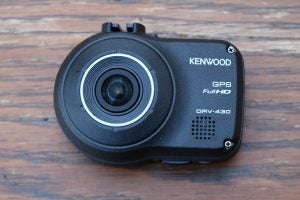
All of the video resolutions are recorded at 27 frames/sec, which is a bit like someone decided to split the difference between European 25 fps and US/Japanese 30fps. At the top resolution, footage is recorded at 16.5Mbps, which is a bit low for Super HD. You can fit around 100 minutes on a 16GB microSD card before looping occurs, with the oldest files overwritten by new ones.
Kenwood DRV-430 – Mounting options
The Kenwood DRV-430 is one of the smaller dash cams I’ve come across, sporting a slightly odd design where the end with the lens is more bulbous than the other. However, its size will mean it fits relatively unobtrusively at the top of your windscreen, behind your rear-view mirror.
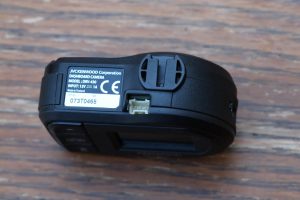
This is clearly a dash cam that’s meant to stay in your car once installed. The only mount included uses an adhesive patch – you don’t even get a second patch in the box for instances where you might want to move the DRV-430 to a different car.
It’s a simple affair, with a ball joint allowing you to position the dash cam correctly. The latter slides onto its mount, but firmly, so it won’t be easy to remove when the car isn’t stationary.
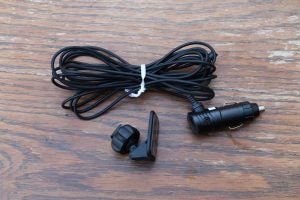
The usual lengthy cable (in this case, 4 metres) with a cigarette lighter adapter at one end is supplied for power connection, but this is captured, so you won’t be able to power anything else at the same time. Also, the end that attaches to the dash cam uses a proprietary plug, so you won’t be able supply your own alternative cable either.
However, you can purchase a CA-DR100 kit for hardwiring the DRV-430 for a completely permanent installation. This would leave your car power socket free and make a parking mode operational. This will be installed via the Halfords weFit service, which costs £30 – or you can get a bundle including the dash cam and 16GB SanDisk microSD card for £130.
Kenwood DRV-430 – Menu and configuration
The LCD screen on the rear of the DRV-430 is one of the smallest I’ve seen on a dash cam with a built-in display. The control buttons, on the other hand, are large and robust. There are only three of these, although there’s also a record button on the bottom of the unit for manually triggering an emergency recording; this button is also used to go back up a level within menus.
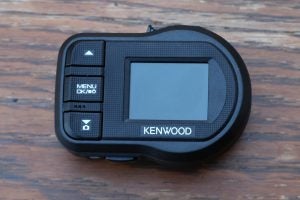
The middle button calls up the main menu, with the other two navigating up and down the options. You can set the individual recording file length at 1, 2 or 3 minutes, and choose between 15, 30 and 60 seconds for manually triggered recordings. The event recordings, caused by the G Sensor detecting a collision or hard braking, have the same time options as manual recordings.
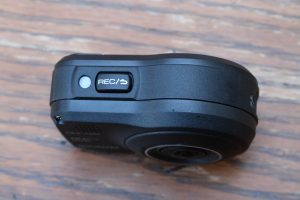
Unusually, the default for the DRV-430 isn’t to overwrite old files once storage is full. Most dash cams do overwrite by default, so you may want to change this setting. Also by default, HDR is enabled to reduce over- and under-exposure in conditions with high brightness contrast. The G Sensor has five levels of sensitivity.
Kenwood DRV-430 – Advanced dash cam features
The DRV-430 has a number of advanced features that you should configure the first time you use the device. You can set the mounting height, with options including 1.2 metres, 1.35 metres and 2 metres (the latter presumably for trucks and vans). There’s a detection range option, and you’ll need to set the horizon and front edge of your car’s bonnet.
Once configured, you can make proper use of the advanced dash cam features available. These include forward collision warning, which detects if you’re too close to the vehicle in front. Lane departure warning notifies you when you stray out of your lane when travelling at 60kph or above. Departure delay warning lets you know when the car in front starts moving in a traffic jam, just in case you stopped paying attention. All of these functioned as expected during testing.
There’s also a built-in GPS, so your location is recorded along with the video footage. This is also necessary for the features above. The parking recording option is only available if you have the CA-DR100 permanent power cabling installed. This leaves the device in standby mode, ready to start recording if a collision is detected.
Kenwood DRV-430 – Image quality
The Kenwood DRV-430’s slightly low data rate for Super HD means its video suffers from obvious compression artefacts. Overall colour reproduction and contrast handling are decent, but if you want to make out specific distinguishing features then you may need to go through footage frame-by-frame until you find one where the details are clear.
Compared to other dash cams I’ve tested, the DRV-430 produces footage that’s around the middle of the pack. It’s certainly fit for purpose, but I’d like to see manufacturers offer a higher data rate for clearer footage; so many promising dash cams are let down by overly harsh compression reducing image quality.
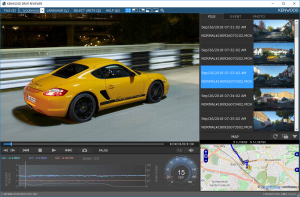
To take advantage of the GPS and G Sensor readings, you can load footage into the downloadable Kenwood Drive Reviewer software, which will show your journeys alongside a map illustrating the recording position. However, the still image grabbing function didn’t seem to work, merely capturing a blank frame.
Why buy the Kenwood DRV-430?
The venerable Kenwood brand and solid build quality give the DRV-430 a head start. Although image quality isn’t the best I’ve seen from Super HD, the fact that you have this resolution available, allied with the healthy feature set and sub-£100 price, makes this a decent dash cam choice.
There are better premium options in the Best dash cam guide, but if you’re not looking to spend more than £100, you get a lot from the DRV-430.
Verdict
The Kenwood DRV-430 provides reasonable dash-cam image quality and lots of features for the money.
The post Kenwood DRV-430 Review appeared first on Trusted Reviews.
Author: James Morris
This article comes from Trusted Reviews and can be read on the original site.
